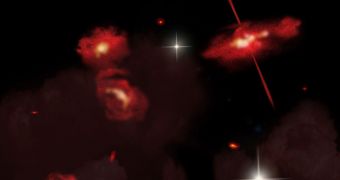While studying the extreme depths of the Universe, in an area located about 13 billion light-years away from Earth, astronomers at the Harvard-Smithsonian Center for Astrophysics (CfA) noticed a type of ultra-red galaxy that they had never seen before.
The objects are so far away, and so well concealed in massive clouds of cosmic dust, that not even the Hubble Space Telescope was able to discover them during its deep-sky surveys. Astronomers found them using the infrared NASA Spitzer Space Telescope.
Using this advanced observatory, scientists discovered four ultra-red galaxies, of a type that was unknown today. While gathering more data about these objects is possible, researchers say that it could be a while before they can advance a potential explanation on how they came to look this way.
One of the reasons why only Spitzer was able to see these galaxies is that they are about 60 times brighter in infrared wavelengths than they are in the reddest images Hubble can observe directly.
In a paper published online in the latest issue of the Astrophysical Journal, CfA astronomer and lead study author Jiasheng Huang explains the challenges he and his colleagues had to face in conducting this research. “We've had to go to extremes to get the models to match our observations,” he says.
Drawing on what astronomers already know about galaxies, there are several scenarios that could lead to the development of very red galaxies. First of all, it could be that they contain vast amounts of cosmic dust within.
Another possibility is that they contain extremely old stars. It is known that stars start out blue, and then slowly move towards red as they grow old. The third scenario revolves around redshift, a phenomenon that stretches the wavelength of light over tremendous distances.
It could be that all three scenarios are valid in the case of the four newly-found galaxies, since they are not mutually-exclusive. CfA experts estimate that the galaxies existed at a time when the Universe was less than a billion years old.
“Hubble has shown us some of the first protogalaxies that formed, but nothing that looks like this. In a sense, these galaxies might be a 'missing link' in galactic evolution,” CfA expert and study coauthor Giovanni Fazio goes on to say.
Since looking at the galaxies in more detail is not possible with Spitzer, experts plan to use radio observatories such as the Large Millimeter Telescope or the Atacama Large Millimeter Array (ALMA) to conduct the investigations.
“There's evidence for others in other regions of the sky. We'll analyze more Spitzer and Hubble observations to track them down,” Fazio concludes.

 14 DAY TRIAL //
14 DAY TRIAL //